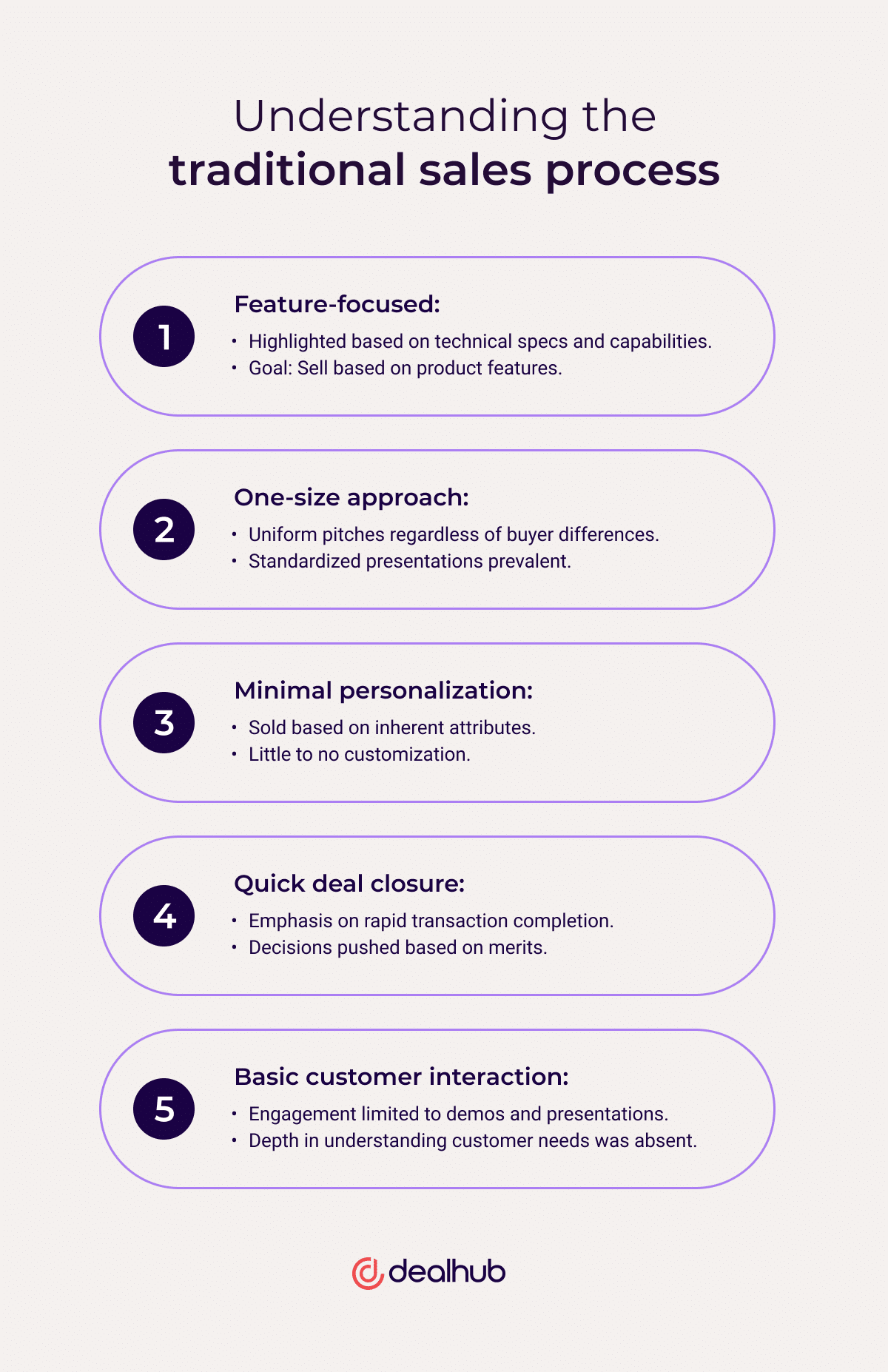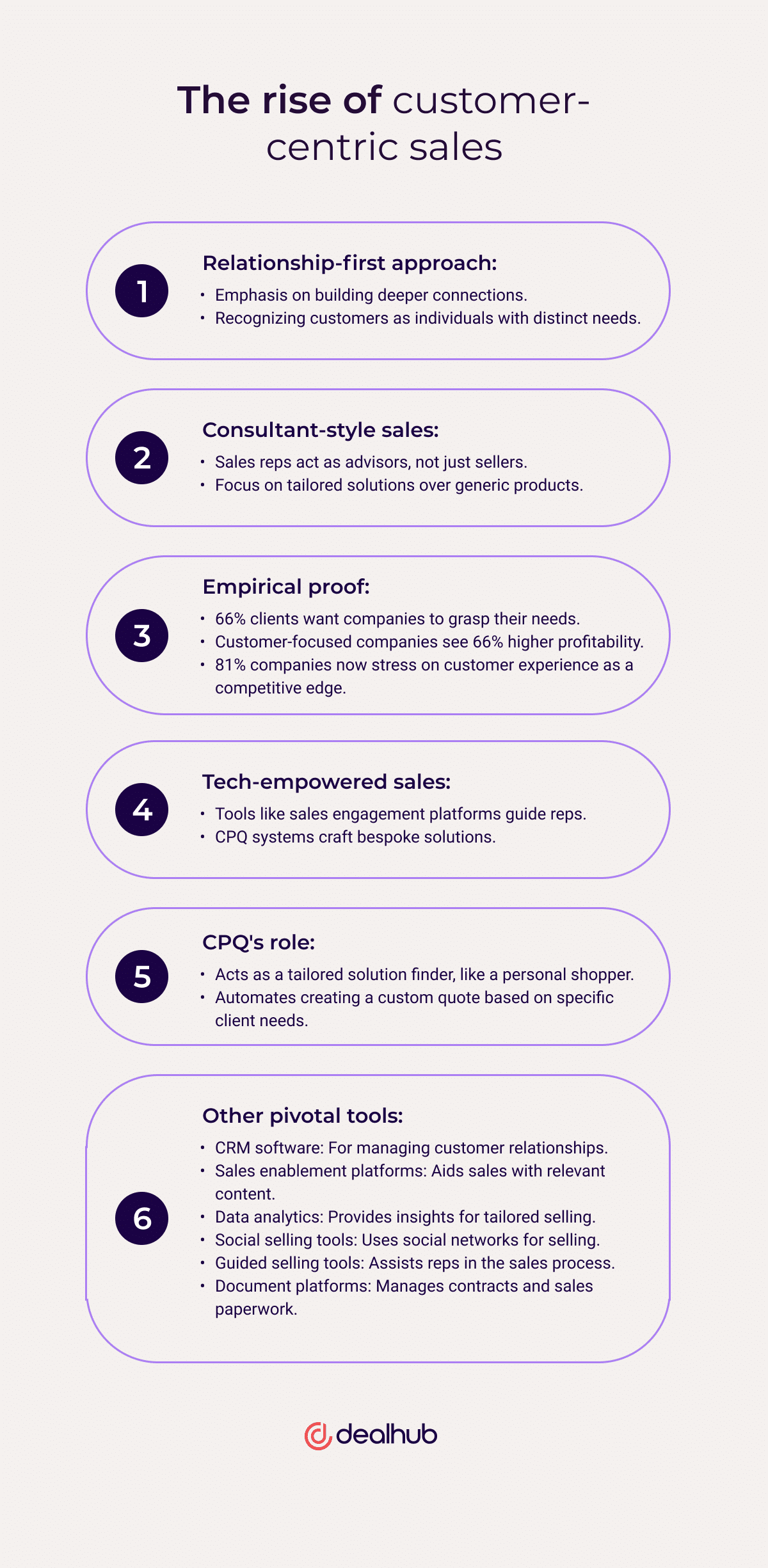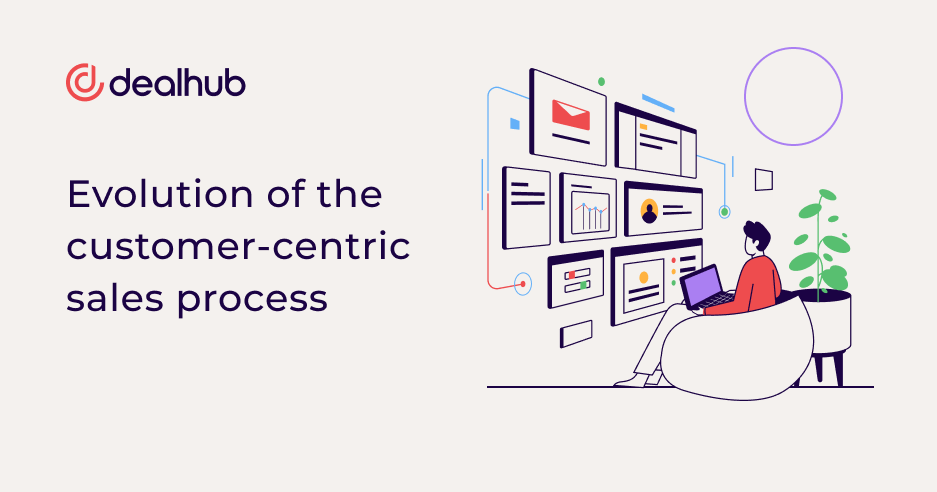Welcome to the brave new world of customer-centric sales! A journey into this approach will showcase how putting your customers smack in the middle of your strategy can skyrocket your success. Let’s jump right in.
Understanding the traditional sales process
In the not-so-distant past, the sales process was transactional and product-focused. Prospects were mere numbers on a spreadsheet, and the goal was to push products out the door with little regard for individual preferences or needs. Sure, it was about getting the job done efficiently, but it lacked that human touch.

The more traditional, product-centric approach to sales looked a lot like this:
- Emphasis on features. Technical specifications, capabilities, and functionalities were emphasized to convince the customer that the product’s features made it the best choice.
- One-size-fits-all. Product-centric sales often involved a standardized pitch. The focus was on presenting the same features to every potential buyer.
- Limited personalization. The main selling point remained the product’s inherent attributes rather than customization.
- Transaction-focused. The goal was to close the sale quickly by pushing for a purchase decision based on features or merits.
- Limited customer engagement: Interaction with the customer would be limited to presentations and demonstrations. The sales process lacked depth in understanding the customer’s broader challenges or long-term goals.
The emergence of customer-centric sales

Today, the spotlight is on customers like never before. Customer-centric sales put “relationship” back into relationship-building. It’s like taking off those corporate blinders and finally realizing that your customers are more than just wallets – they’re real people with unique challenges, desires, and aspirations.
In this new era, sales professionals aren’t just pushing products; they’re solving problems and understanding the industry like never before to take on a role of trusted advisor. Sales representatives these days act more like consultants tasked with finding their clients the perfect customizable solution – not a one-size-fits-all answer.
The proof is in the numbers when it comes to the success of customer-centric sales. For example:
- 66% of clients expect companies to understand their requirements
- Customer-centric companies are 66% more profitable
- 81% of companies compete or expect to compete completely on the basis of customer experience
Gathering the right tools for the job
The numbers are clear: to succeed, sales representatives must build more in-depth customer relationships. Luckily, they also have more assistance, thanks to technology. Whether it’s a sales engagement tool that guides them through options or a Configure, Price, Quote (CPQ) system that crafts tailored solutions, technology is stepping up to make this customer-centric approach possible.
Let’s talk about CPQ for a second. Think of CPQ as a personal shopper. It knows your preferences, needs, and budget and can find the perfect fit. With CPQ augmenting the sales representative’s knowledge and insights, sales teams are crafting a more personalized experience for the customer.
CPQ assembles a unique solution based on a customer’s exact requirements with a click of a button. While the sales representative does all the heavy lifting of qualifying the client and their needs, CPQ streamlines the experience of creating a customized quote. Leveraging automation, it considers all aspects of what a customer has shared (or purchased in the past) to provide the best possible product or service.
CPQ is just one tool in a sales representative’s toolbox. Other solutions also make the sales process more client-focused, whether making processes frictionless or enabling sales representatives to personalize interactions more effectively. Other tools great for a customer-centric sales approach include:
- CRM software
- Sales enablement platforms
- Data analytics and insights tools
- Social selling tools
- Guided selling tools
- Document and contract management platforms
Key components of a customer-centric sales process
The secret to customer-centric success is a blend of tech and touch, data and intuition. Comprehensive data analysis and customer profiling can be a blueprint for approaching a customer. Integrating technology, like CPQ, CRM, and sales enablement platforms, isn’t about replacing humans; it’s about giving them superpowers. Customer-centric sales may use a lot of technology, but it works as effectively as it does because of the human components at the center of it all.
So think of these technological tools as digital personal assistants. They can remind you to follow up, give you insights into a client, and point to areas where you can effectively upsell or cross-sell. Still, the real power is in the human team that becomes the face of the company and can build and nurture that customer relationship by sharing insights, strategies, and goals. Together, human and technology elements create a united front that showcases to the customer an understanding of their needs while providing solutions to address them.
Benefits of customer-centric sales
Customer-centric sales bring a host of benefits that go beyond just closing deals. It’s about creating lasting relationships, building trust, and delivering value that resonates with customers. Here are some of the key benefits of adopting a customer-centric sales approach:
- Enhanced customer satisfaction. By understanding and addressing customers’ unique needs and preferences, you provide solutions that genuinely help. This increases customer satisfaction and loyalty, as they feel valued and cared for.
- Improved customer retention and less churn. When you focus on a customer’s needs, you’re not just making a sale; you’re building a foundation for long-lasting partnerships that continue to provide value over time.
- Increased conversion rates. Tailoring your sales approach to match individual customer needs increases the likelihood of closing deals.
- Higher sales revenue. Satisfied customers are more likely to explore additional offerings, leading to higher average deal sizes and increased revenue streams.
- Brand differentiation. Providing a personalized, customer-focused experience in a competitive marketplace sets you apart.
- Increased cross-selling and upselling opportunities. When you understand your customer’s pain points and needs, you can identify opportunities for cross-selling complementary products or upselling more advanced solutions.
- Reduced sales cycles. You can expedite decision-making by addressing customer concerns and providing relevant information early in the sales process.
- More accurate sales forecasting. A deeper understanding of customer behavior and preferences enables more accurate sales forecasting for better resource planning.
- Adaptation to customer/market trends. Customer-centric sales forces you to pay close attention to changing customer preferences and trends. This agility enables you to pivot quickly and adapt to evolving market demands.
- Long-term business growth. The benefits of customer-centric sales accumulate over time, resulting in a strong foundation for sustained (and predictable) business growth.
- Innovation and product improvement. Regular customer interactions provide valuable insights that can drive innovation and product development.
Overcoming challenges in implementing customer-centric sales
Now, let’s address the elephant in the room: change. Customer expectations are evolving faster than you can say “innovation.” But remember, while change always is a bit uncomfortable at first, it gets easier to adapt to over time.
Let change management be your anchor. You’ll need it to assist your sales team when navigating the shifting landscape and embracing the customer-centric mindset. Training is also critical. Your team needs to be equipped with the right tools and techniques to deliver that personal touch while maintaining efficiency. Provide them with everything they need to succeed via sales enablement, and they’ll be able to better serve both prospects and existing clientele.
Remember not to sacrifice human interactions in the name of efficiency. Balancing automation with human touchpoints is the secret sauce. Create workflows that can automate away admin while leaving client interactions to human beings.
The continuous evolution of sales processes
There you have it – the journey from transactional to customer-centric sales! It’s a transformation that isn’t just about selling; it’s about creating connections that stand the test of time. The evolution to customer-centric sales puts human interaction at the center of the story – while technology streamlines and buffers real-world engagements.
So, gear up, fellow sales warriors, because the future is all about making meaningful connections, crafting tailored solutions, and creating unforgettable customer experiences. Remember, the heart of every sale isn’t just a product; it’s the person on the other side of the conversation. Finding meaningful, customizable solutions to customer pain points is the name of the game, and investing in that human touch can pay dividends. Cheers to customer-centric success!









